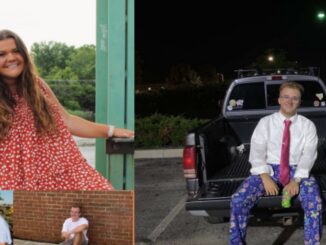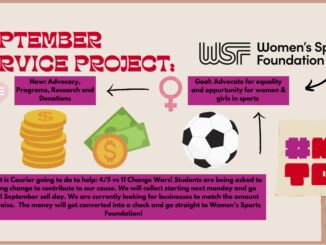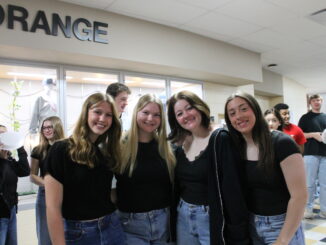
design: Brooke Farren and Carissa Long
It is beyond the shadow of doubt that 2020 has been full of surprises. With the pandemic being at the center of it all, thousands of people have been affected in some way, shape or form. Many of which happen to be part of students in the district.
Earlier in the spring, states announced school closure due to COVID-19. For most schools, this was merely a temporary solution for the safety of students and staff. All school buildings within the Olentangy district closed on March 16 with two weeks of virtual learning before an already-scheduled spring break. However, the break gradually turned into a total physical shutdown for the remainder of the school year for most schools all across America.
Class of 2020 graduate and current University of Michigan student Maddie Miller said that the closing of school was honestly something that was difficult to cope with, being so close to the end of her high school chapter. She felt like she “didn’t really get any closure and that makes it difficult to move past.”
Proms, graduation and other senior traditions soon got postponed, if not cancelled. It wasn’t long before high school seniors were hit with the harsh reality that they were going to be robbed of a right of passage.
“[It’s going to be] difficult to hear when parents or older relatives say how much ‘easier and more special’ these celebrations were because we never got to experience a typical graduation or senior awards night,” Miller said.
COVID-19 impacted some in a closer way than others. 2020 graduate Grayson Bell had a first-hand experience of contracting COVID-19 early on in the pandemic while still completing her school work and preparing herself for college.
Bell found out she had COVID-19 on April 14 after taking a test at Nationwide Children’s Hospital.
“My parents were not surprised by my positive COVID-19 test. My mom got very sick about three weeks before I was tested, but she was unable to get tested due to lack of testing at the time. Having more tests then, the doctors were able to conclude that she had COVID-19 due to her symptoms, and they concluded the same for my dad too. The only reason I was able to get tested was due to my Cerebral Palsy, and once I tested positive, we were able to confirm that my whole family had it, so I likely got it from them,” Bell said.
Eventually, everyone in Bell’s family contracted the virus.
“COVID-19 affected everyone in my family differently. My mom had it the worst; she had body aches, a high fever for 11 days, hot and cold flashes, a hard time breathing and fatigue. My dad and sister were both very run down, and they both lost their sense of taste and smell.
“I had it the easiest out of my family as I was just very tired, had headaches and body aches. It was crazy to see how differently COVID-19 impacted everyone in my family symptom wise,” Bell said.
Bell may have suspected she had COVID-19, but never did she think she would have to isolate herself in her own bedroom in her own home.
“It felt like I slept all day every day. I could not stay awake for more than an hour at a time due to my raging headaches and body aches. While trying to complete my assignments, I found myself very fatigued and constantly getting headaches. At certain times, I could only work on my assignments for 20-30 minutes before falling asleep because of getting a migraine,” Bell said.
Even those without the virus had to stay home for a long period of time because of quarantine.
While time away from school may have sounded like joyous news to some students, practicing social distancing for that long was tough, especially for a group of students who were supposed to be out experiencing a significant milestone.
Class of 2020 graduate Khameron Macarthy, who’s currently attending the Ohio Dominican University, said that he read, worked out, cooked and wrote to stay productive during that time. He was focused on staying positive as “it does [his] heart well to know that the sun will rise again.”
The pandemic has caused the district to adjust its policies in a way that keeps students safe while allowing them to have as many experiences as possible. Those who have to create these policies face difficult decisions often on a weekly and even daily basis according to Assistant Director of Human Resources Nancy Freese.
“The district leadership team is in charge of the decision making and is working very closely
in conjunction with the center of disease control (CDC), all local health departments and officials including the Delaware Health District, as well as other superintendents throughout Central Ohio to work collectively,” Freese said. Those decisions are often made during weekly
meetings in regards to COVID-19; however, changes are considered daily. The ability to have physical learning at school is a combined decision with higher levels of authority, according to Freese.
“The governor will tell us non-negotiables (meaning actions that are off limits). However, localized and district decisions are determined based on the decision-making flexibility that the
governor provided us and his mandates with the information we all have at the time,” Freese said.
Despite all that was handed to it, the class of 2020 was able to make it through the quarantine and move on to college, in whichever form it may take.
Most colleges have done what they can to abide by social distancing guidelines, while accommodating students who wish to return. The University of Cincinnati, where Bell now attends, is bringing students back to campus.
Grayson’s mother, Denise Bell, wishes that even with COVID-19, Grayson is enjoying college life and wanting her to have a sense of normalcy while away.
“When the University of Cincinnati announced that students would be permitted to live in the
dorms, we were all excited that Grayson would be able to begin her college experience on campus. Although the majority of her classes would be remote, we felt that it was important for her to be able to move forward with whatever aspects of campus and college life that were allowed,” Denise said.
At the University of Michigan- Ann Arbor, Miller is currently planning to major in
Economics with a possible minor in Spanish. All of her classes are presently virtual with the
majority of them being homework and zoom meetings.
“I [do] have one asynchronous class that means I just do the work on my own time and
meet with a graduate student instructor at the end of the week,” she said.
The pandemic hasn’t only affected school, though. Sports and activities outside of class
have changed greatly for those still in the district as well.
Sports decision making (for high school sports) stems from the Ohio High School
Athletic Association (OHSAA), according to Freese.
OHSSA “gives us very specific guidelines for how we slowly transitioned back into athletic practices so the athletic leadership comes through that organization,” Freese said.
As for clubs and electives, they work slightly differently as they provide an opportunity to use alternative ways of participating, like virtually, as opposed to sports that mostly require physical practices and contests, according to Freese.
“For activities, it looks a little different as safety is always our goal; we are highly encouraging online resources to be utilized primarily, and if not we make sure to always maintain the social distancing requirement,” Freese said.
Activities and sports are an important part of the community and community discussion. The
district plans to uphold the importance of these extracurriculars, according to Assistant Director of Communications Amanda Beeman.
“We know that extracurricular activities are an integral part of the learning experience, and so we plan to continue those activities in some form as long as we can,” Beeman said.
College also now looks much different than it ever has before. These adaptations and erasing
of expectations are things that the class of 2020 has gotten used to making by now.
“Campus is not how I would imagine. Anywhere you go you have to wear a mask unless you are eating or drinking. Many places such as the library and study rooms close earlier now to limit gatherings. Finally, every day we are required to complete an eight-question survey
on our UC Covid Check app that determines whether we are allowed to be on campus and use campus resources each day,” Bell said.
With gatherings being limited, restrictions have been put in place all throughout the university to maintain social distancing.
After graduation and prom were cancelled in high school, the theme remained the same in
college, with many activities being moved online or cancelled altogether.
“Welcome week was all virtual events like Netflix parties and kahoots, when typically there
are events happening all week around campus. Personally, I just went through rush, a Greek life process, at UC, and it was all over zoom. It had a very different feel because I couldn’t talk to the girls face to face and make more personal connections. However, at the same time, it kind of took away some of the nerves,” Bell said.
While campus is a whole different look now so are classes and the learning styles.
“Being in college during the pandemic has definitely been difficult. As a nursing major, I take many science courses, which have been moved to all online, and our lab times have been cut in half to reduce our exposure to others,” Bell said.
Denise Bell has encouraged her to take any and every opportunity she has for in-person learning.
“As parents, one of our biggest concerns is the additional workload and stress that comes with
having about 85 percent of her schedule being virtual. Being a nursing major, Grayson’s schedule is science and lab heavy, and those are not the type classes that are easy to complete online. Additionally, only one of her classes is actually being taught live – the rest are recorded lectures and notes,” Denise said.
With the introduction of the hybrid schedule and a committed distance learning option, high school academics has had to shift from its normal as well.
Beeman said the district is paying close attention to the effects of different weekly models
on the students.
“We are continuing to monitor and assess how learning is affected in the hybrid and other models and the current COVID-19 climate and the cases we are seeing each week, as well as listening to the governor’s guidelines to decide which method should be used during that time,” Beeman said.
Not only is the district monitoring the academic impact on students, it is also providing resources to help ensure the teachers have the tools needed to effectively teach regardless of the circumstance, according to Freese.
“As to help with the teachers now reliant on online resources more, we have added a technology review committee to ensure privacy, and we’re constantly making sure that all teachers have access to the correct resources for each grade level,” Freese said.
To make the community more comfortable, the district urges everyone to keep in mind that flexibility will majorly benefit the environment created this year, and the district plans to be mindful of creating the best environment possible, according to Freese.
“People are coming into or doing distance learning with different levels of fear and our leadership team is cognizant of that, and each member of our community might handle the information differently depending on each individual. We want to provide resources to create a support system for each member,” Freese said.
The pandemic has called for students and families to create ways to cope and adapt to the new look of education.
“As a family, we made the decision that we would focus on the positive! As parents, we encouraged Grayson to embrace whatever opportunities she was given, and to remember that this was her college experience and she needed to make the most of the situation – focusing on what ‘she couldn’t do,’ would not change anything. Although it would be different than what is typical, she had the control to make it a positive experience,” Denise Bell said.
After having COVID-19, it opened Grayson’s eyes to the world around her; she has become more aware of her surroundings and hesitant when it comes to being in contact with germs. She has since done what she can to keep the areas around her sanitized to prevent future sickness related to COVID-19.
Macarthy is one example of not allowing oneself to be beaten by the pandemic. His positive mindset has allowed for him to move forward in his life beyond COVID-19.
At a recent staff convocation, he was asked to give a message of hope. His speech was so inspirational that it was well-received throughout the district and highly praised by the community.
He said while the speech didn’t give him any closure, it was more of a call to action. So he did his best to call on staff to have “hope and faith in themselves, the kids they’ll work with and tomorrow as a whole.”
Macarthy lost two family members due to COVID-19. However, he refused to let the negativity of the pandemic invade his mind, giving it any more control.
He said though some things may be harder to achieve now, his aspirations remained unchanged as “pandemics do not have the power to rob one of a true dream.”


